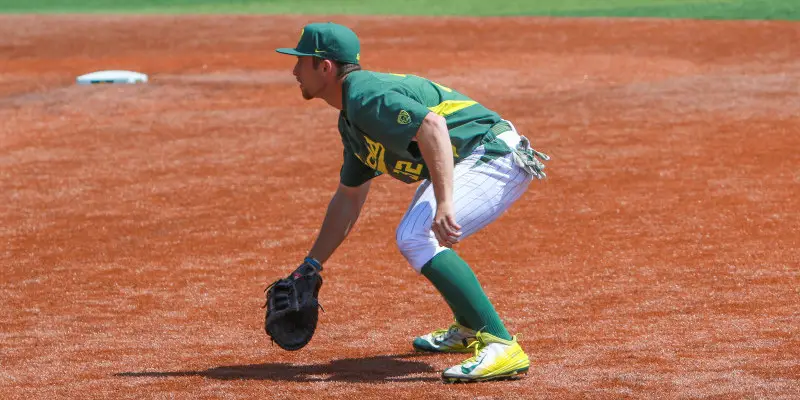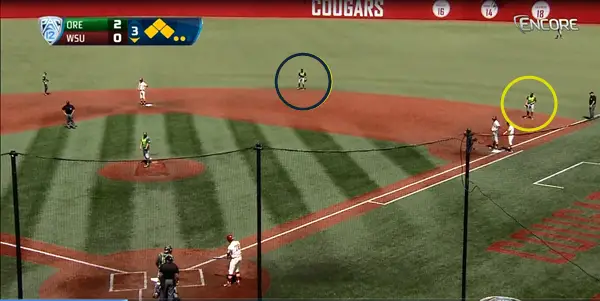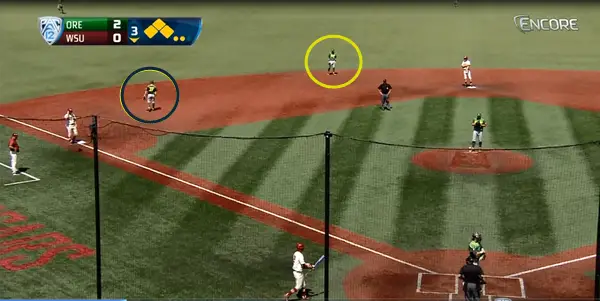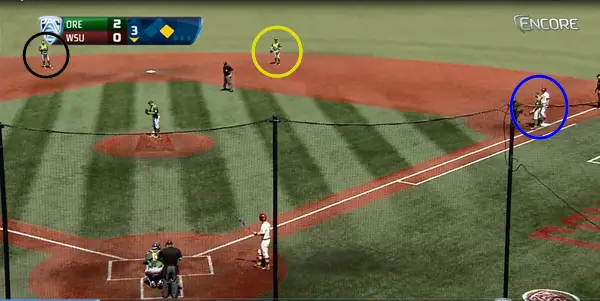Defensive positioning in baseball has changed dramatically over the years as managers are looking at every detail of the game. Getting advanced statistics on the batter and shifting players into the correct defensive positions are a few examples. The defensive shifts implemented during the game can be interesting to see for fans – new and old — of baseball.
In a game against Washington State, Oregon head coach George Horton positioned his Ducks defensively around the diamond depending on the situation — hitter/count/outs. In this analysis, I will be taking an in-depth look at two defensive shifts the Ducks implement on defense.
Normal Depth
Despite the bases being loaded for Washington State, the players on defense for Oregon are in normal depth positioning — seen above. Since there are two outs in the inning, the play is to be made at first for the out. Look at the position of Oregon’s second baseman, Daniel Patzlaff — blue circle, above — standing near the edge of the outfield grass. Patzlaff is also standing away from second base so he can cover the gap between he and the first baseman — should the ball come his way.
First baseman, Scott Heineman — yellow circle, above – with the bases loaded, Coach Horton elected to position Heineman back toward the outfield, covering the right field foul line to prevent an extra base hit. If the bases were empty, Heineman would be playing closer to the bag for “normal depth.”
Notice shortstop, Mark Karaviotis — yellow circle, above — played a few steps in front of the outfield and third baseman, Mitchell Tolman — blue circle, above — played inwards and away from third base. The two are then positioned to cover the gap from a ball going to left field.

A nice play.
This style of positioning allows the infielders time to cleanly field the ball and make a play for the out. The GIF above shows Tolman’s hustle to field and scoop the ball to pitcher, Josh Graham, for the out at first base.
Double Play Depth
With a runner on first base for Washington State, Oregon shifted their defense in hopes of a double play. In the image above, notice the position of Karaviotis — black circle — Patzlaff — yellow circle — and Heineman — blue circle. Karaviotis and Patzlaff are playing near second base and shallow. The two players are in position to start — and turn — a double play.
Now, in order for a chance at a double play, Tolman needs to hold the runner at first base. If Tolman chose not to hold the runner, the chance of stealing second base or a possible hit-and-run is high — which eliminates the potential of a double play. The third baseman cannot be seen in the image, but he is playing close to third base — ready to charge on a possible bunt attempt.

Another great play.
Unfortunately, a double play did not happen in this instance — seen in GIF above — but it shows the position and the start of turning a double play. Patzlaff had to wait on the ball bounce before he could field, turn, and throw a strike to Karaviotis to get the lead runner out at second. If the ball came quicker, a double play could have been executed.
This style of positioning is a good strategy for turning the double play, but a disadvantage is a wide gap between the first and second basemen — which is where the hitter is looking to hit the ball. There is also a wide gap between the third baseman and shortstop.
Finally
These are two basic but critical defensive shifts the Ducks implement during a game to shut down an offense. They use other defensive positions as well, but those will be broken down in a future analysis. Look for these two positions as the Ducks look to prevent runs and ‘Win the Day.’
It is baseball, and ”Oh how we love to learn about our beloved Ducks!”
Andrew Bet
Oregon Baseball Analyst for CFF Network/FishDuck.com
Eugene, Oregon
Top Photo by John Sperry
Related Articles:
Oregon Enters Playoffs Better Off Than Last Year
Will The Coaching Carousel Kill Oregon's CFP Chances?
The Playoff Formula Hasn't Changed
Oregon Aims to Bury Dawgs, Punch Playoff Ticket in Rivalry Clash
Huskies Are the New Beavers, Stay In Your Lane Kiffin, and the Civil Apple Cup War
Oregon Football: The X-Factor Vs. Washington
My name is Andrew Bet and I am currently a Journalism student at the University of Oregon. Born in Bethlehem, PA and raised in San Mateo, California it was easy for me to kindle an interest in sports considering all the college and professionals teams who call the Bay Area home. Some of the teams I enjoy following are the University of Oregon, Stanford, San Francisco Giants, San Jose Sharks, Oakland A’s, San Jose Earthquakes, Philadelphia Eagles and Flyers and the European Soccer League. During my youth, I played soccer and baseball. Today, I enjoy playing golf and bowling. My dream is to combine writing and my passion for sports and become a sports writer for one of my favorite teams. Follow me on Twitter: @ACB_Ducks12




